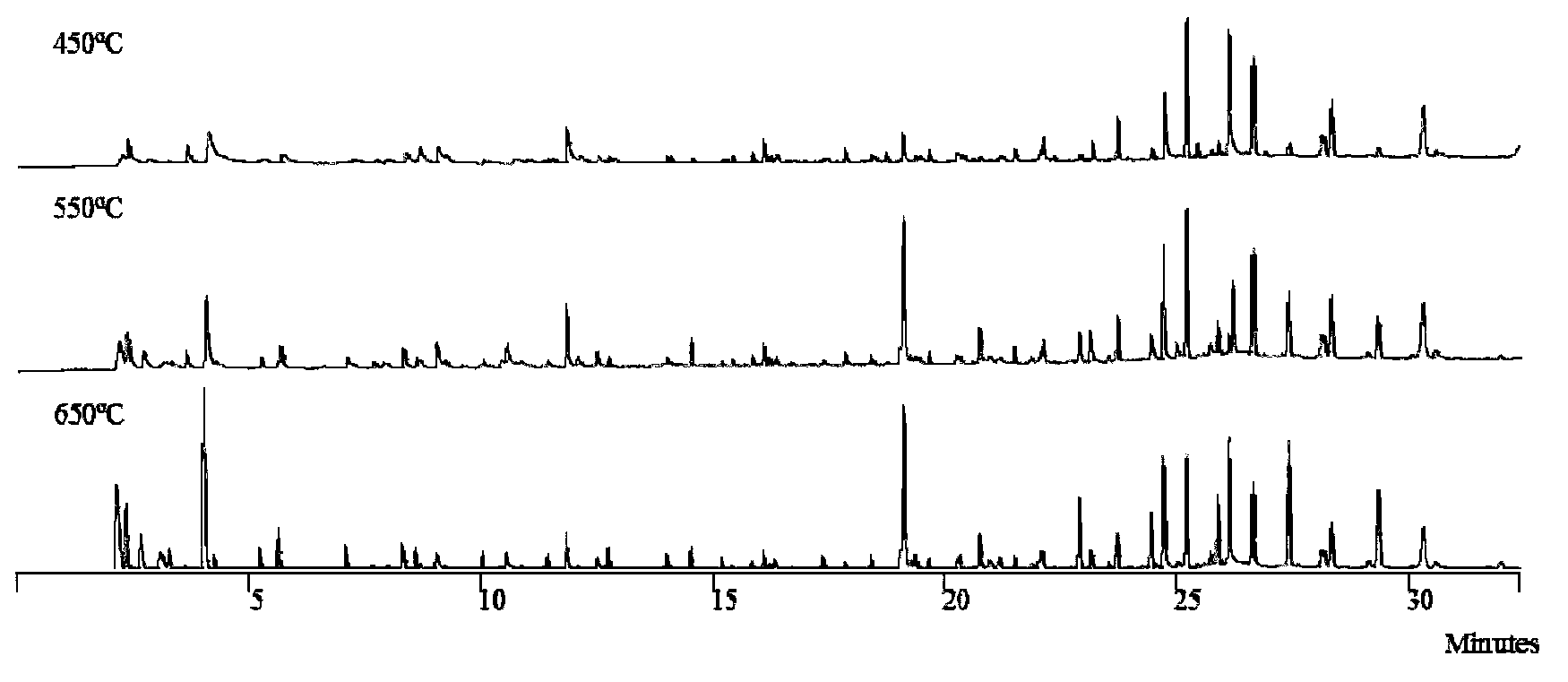Method for analyzing propolis chemical components through pyrolysis gas chromatography-mass spectrometry
A technology for cracking gas chromatography and chemical components, applied in the field of analysis of chemical components of propolis, can solve the problems of complicated operation, laborious, difficult to react to the composition and characteristics of propolis, simplifies experimental steps, saves experimental time, and has far-reaching rapid evaluation. Effect
- Summary
- Abstract
- Description
- Claims
- Application Information
AI Technical Summary
Problems solved by technology
Method used
Image
Examples
Embodiment 1
[0024] The selection of embodiment 1 cracking temperature
[0025] (1) Instruments and reagents
[0026] American Thermo Finnigan Trace DSQ gas chromatography / mass spectrometry (GC-MS); American Varian CP-3800 gas chromatograph with hydrogen flame detector (FID); Japanese Frontier PY-2020iD double-click vertical micro furnace cracker .
[0027] Purchase fresh propolis glue from Shandong Tai'an, Shandong Linyi, Hubei, and Zhejiang bee farms, remove visible sawdust, bee corpses and other debris, freeze overnight at -20°C, take it out and quickly grind it through a 120-mesh sieve to make propolis powder. spare.
[0028] (2) Experimental method
[0029] 1) Selection of pyrolysis temperature
[0030] Accurately weigh 0.1 mg of Shandong Taian propolis powder and put it into the sample cup, fix it on the injection rod, and put it into the cracker installed above the GC inlet, and the sample is at room temperature at this time. After the temperature of the cracker reaches the app...
Embodiment 2
[0036] The investigation of embodiment 2 reproducibility
[0037] American Varian3800 gas chromatograph (UA-5 metal capillary column, 30m×0.25mm i.d.×0.25μm, film thickness 5% methylpolysiloxane, Japan), Japan Frontier PY-2020iD double-click vertical micro-furnace cracker.
[0038] Gas phase conditions: heating program: initial temperature 40°C, rise to 300°C at a rate of 10°C / min, and keep for 10 minutes; inlet temperature is 300°C, detector temperature is 300°C, split ratio 30:1; carrier gas nitrogen or Helium, flow rate 1.0mL / min.
[0039] Cracker conditions: cracking furnace temperature: 550°C; interface temperature between cracker and gas chromatograph: 350°C;
[0040] Accurately weigh 3 parts of Shandong Tai'an propolis powder 0.1 mg prepared by the method in Example 1, put them into a sample cup, fix it on the sample rod, and put it into the cracker installed above the GC sample inlet, and the sample is at room temperature at this time. When the temperature of the cra...
Embodiment 3
[0042] Embodiment 3 propolis content analysis
[0043] Gas chromatography / mass spectrometry (GC-MS) from Thermo Finnigan Trace DSQ in the United States; Frontier PY-2020iD double-click vertical micro-furnace cracker from Japan.
[0044] The gas phase conditions are: the chromatographic column is a UA-5 metal capillary column (30m×0.25mm i.d.×0.25μm, film thickness 5% methyl polysiloxane, Japan). The min rate was increased to 300°C and kept for 5min; the inlet temperature was 300°C, the detector temperature was 300°C, the split ratio was 30:1; the carrier gas was nitrogen or helium, and the flow rate was 1.0mL / min.
[0045] The mass spectrometry conditions are: electron bombardment ion source, ion source temperature 230°C, transfer line temperature 300°C, ionization energy 70eV, ion scanning range 40-550m / z.
[0046] Cracker conditions: cracking furnace temperature: 550°C; interface temperature between cracker and gas chromatograph: 350°C.
[0047] Accurately weigh 0.1 mg of ...
PUM
 Login to View More
Login to View More Abstract
Description
Claims
Application Information
 Login to View More
Login to View More - R&D
- Intellectual Property
- Life Sciences
- Materials
- Tech Scout
- Unparalleled Data Quality
- Higher Quality Content
- 60% Fewer Hallucinations
Browse by: Latest US Patents, China's latest patents, Technical Efficacy Thesaurus, Application Domain, Technology Topic, Popular Technical Reports.
© 2025 PatSnap. All rights reserved.Legal|Privacy policy|Modern Slavery Act Transparency Statement|Sitemap|About US| Contact US: help@patsnap.com



